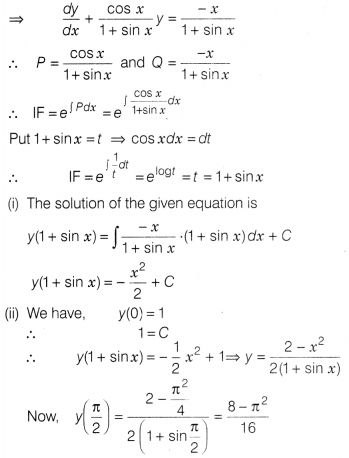CBSE Sample Papers for Class 12 Maths Set-4
Class 12thCBSE Sample Papers for Class 12 Maths Set-4
CBSE Sample Papers for Class 12 Maths Set 4 with Solutions
Time Allowed: 3 Hours
Maximum Marks: 80
General Instructions:
- This question paper contains – five sections A, B, C, D and E. Each section is compulsory. However, there are internal choices in some questions.
- Section A has 18 MCQ’s and 02 Assertion-Reason based questions of 1 mark each.
- Section B has 5 Very Short Answer (VSA) type questions of 2 marks each.
- Section C has 6 Short Answer (SA) type questions of 3 marks each.
- Section D has 4 Long Answer (LA) type questions of 5 marks each.
- Section E has 3 source based/case/passage based/intergrated units of assessment (4 marks each) with sub-parts.
Section
A
(Multiple Choice Questions)
Each question carries 1 mark
Question 1.
The area of the region bounded by the curve y =
\(\frac{1}{x}\), the X-axis and between x = 1 to x = 6 is
(a) loge
3 sq units
(b) loge 6 sq units
(c) log5 sq units
(d) 6 sq
units
Solution:
(b) Required area = \(\int_1^6\)y dx =
\(\int_1^6\frac{1}{x}\) dx
= [log x]61
=
loge 6 sq units.
Question 2.
The rate of change of the area of a circle with respect to its
radius r, when r = 3 cm, is
(a) \(\frac{6\pi}{5}\)cm²/cm
(b) 3π cm²/cm
(c) 6π cm²/cm
(d) \(\frac{3\pi}{5}\)cm²/cm
Solution:
(c) Area of circle
= πr²
i.e. A = πr²
\(\frac{dA}{dr}\) = 2πr
(\(\frac{dA}{dr}\))r=3 = 2π(3)
= 6π cm2/cm
Question 3.
possible pair of values of x and y, if x and y are natural
numbers.
(a) 1
(b) 2
(c) 3
(d) 4
Solution:![]()
⇒ 3 – xy = 3 – 8 ⇒ xy = 8
⇒ (x, y) = (1, 8), (2, 4), (4,
2), (8, 1)
Question 4.
The value of ∫x² ex³dx is
(a) \(\frac{1}{3}\)
ex³ + C
(b) \(\frac{1}{3}\) ex4 + C
(c)
\(\frac{1}{2}\) ex³ + C
(d) \(\frac{1}{2}\) ex² + C
Solution:
(a) Let ∫x² ex³ dx
Put x³ = t ⇒ 3x²dx = dt
∴ l =
\(\frac{1}{3}\)∫et dt = \(\frac{1}{3}\)et + C ⇒ l =
\(\frac{1}{3}\)ex³ + C
Question 5.
If y = 3e2x + 2e3x then the value of
y2 – 5y1 + 6y is
(a) 1
(b) 0
(c) 2
(d) 3
Solution:
(b) We have, y = 3e2x + 2e3x
y1
= 6e2x + 6e3x
y2 = 12e2x +
18e3x
y2 = 6(2e2x + 3e3x)
Hence,
y2 – 5y1 + 6y = 6(2e2x +
3e3x) – 30(e2x + e3x) + 6(3e2x +
2e3x)
= 0
Question 6.
If the function f defined as
x = 3, then the value of k is
(a) 1
(b) 2
(c) 6
(d) 5
Solution: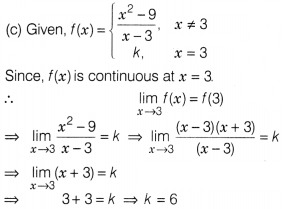
Question 7.
For what values of a, the vectors
\(\hat{i}-3\hat{j}+4\hat{k}\) and \(a\hat{i}+6\hat{j}-8\hat{k}\) are
collinear?
(a) 4
(b) -4
(c) -2
(d) 2
Solution: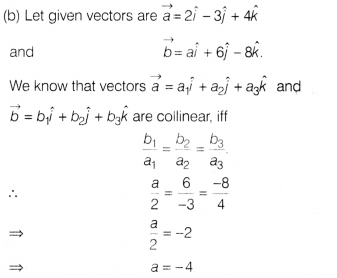
Question 8.
If P(A) = \(\frac{1}{2}\), P(B) =0, then P(\(\frac{A}{B}\))
is
(a) zero
(b) 2
(c) not defined
(d) 11
Solution:
(c) It is
given that P(A) = \(\frac{1}{2}\) and P(B) = 0![]()
Therefore, P (\(\frac{A}{B}\)) is not defined.
Question 9.
If f'(1) = 2 and y = f (loge x), then find
\(\frac{dy}{dx}\) at x = e.
(a) \(\frac{2}{e}\)
(b) \(\frac{3}{e}\)
(c)
\(\frac{1}{e}\)
(d) \(\frac{2}{5e}\)
Solution:
(a) We have, y =
f(loge x)
∴ \(\frac{dy}{dx}\) = f'(loge
x).\(\frac{1}{x}\)
Now, on putting x =e, we get
\(\frac{dy}{dx}\)|x=e = f'(loge e).\(\frac{1}{e}\) =
\(\frac{1}{e}\)f’(1) [∵ logee = 1]
= \(\frac{2}{e}\) [∵ f'(1) =
2]
Question 10.
The particular solution of the differential equation
\(\frac{dy}{dx}\) = y tan x at y = 1, x = 0 is
(a) y = cos x
(b) y = sec
x
(c) y sin x = 6
(d) y = tan x
Solution:
(b) We have,
\(\frac{dy}{dx}\) = y tan x ⇒ \(\frac{dy}{y}\) = tan x dx
⇒ ∫\(\frac{dy}{y}\)
= ∫tan x dx
⇒ log y = log |secx| + C
On putting y = 1 and x = 0 in (i), we
get
C = 0
∴ y = sec x
Question 11.
\(\int_1^4\)|x – 5| dx is equal to
(a)
\(\frac{15}{2}\)
(b) \(\frac{13}{2}\)
(c) 1
(d) 4
Solution: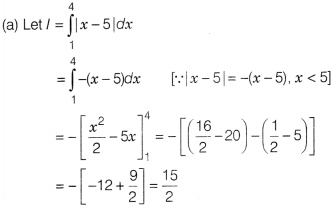
Question 12.
The value of p, for which the vectors
\(3\hat{i}+2\hat{j}+9\hat{k}\) and \(\hat{i}-2p\hat{j}+3\hat{k}\) are parallel,
is
(a) –\(\frac{1}{3}\)
(b) \(\frac{1}{3}\)
(c) 2
(d)
\(\frac{1}{\sqrt3}\)
Solution:
(a) Given, \(3\hat{i}+2\hat{j}+9\hat{k}\)
and \(\hat{i}-2p\hat{j}+3\hat{k}\) are two parallel vectors, so their direction
ratios will be proportional.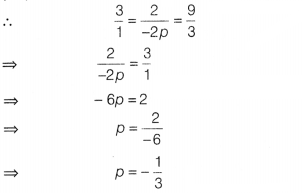
Question 13.
The degree of the differential equation
\((\frac{dy}{dx})^5=2x^2(\frac{d^2y}{dx^2})^4\) = 0 is
(a) 1
(b) 2
(c)
3
(d) 4
Solution:
(d) Degree = 4
Question 14.
The minimum value of the function f(x) = |x – 4| exists
at
(a) x = 0
(b) x = 2
(c) x = 4
(d) x = -4
Solution:
(c)
Given function, f(x) = | x – 4|
Graph of f(x),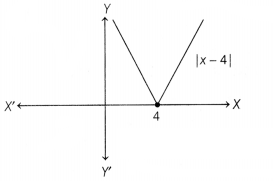
From graph, we observe that f(x) has minimum value at x =
4.
Question 15.
The function f: N → N, N being the set of natural numbers,
defined by f(x) = 2x + 3 is
(a) injective and surjective
(b) injective but
not surjective
(c) not injective but surjective
(d) neither injective nor
surjective
Solution:
(b) Given, f: N → N defined by f(x) = 2x + 3
Let
f(x1) = f(x2)
⇒ 2x1 + 3 = 2x2 +
3
⇒ x1 = x2
Hence, f(x) is injective.
Let f(x) =
y
⇒ y = 2x + 3
⇒ x = \(\frac{y-3}{3}\)
Let y = 4
i.e. y ∈ N
but x ∉ N.
Hence, f(x) is not surjective.
Question 16.
The corner points of the feasible region determined by the
following system of linear inequalities 2x + y ≤ 10, x + 3y ≤ 15, x, y ≥ 0 are
(0, 0) (5, 0) (3, 4) and (0, 5). Let Z = px + qy, where p, q > 0. Condition
on p and q, so that the maximum of Z occurs at both (3, 4) and (0, 5), is
(a)
p = q
(b) p = 2q
(c) p = 3q
(d) q = 3p
Solution:
(d) The maximum
value of Z is unique.
It is given that the maximum value of Z occurs at two
points (3, 4) and (0, 5).
Value of Z at (3, 4) = Value of Z at (0, 5)
⇒
p(3) + g(4) = p(0) + q(5)
⇒ 3p + 4q = 5q
⇒ 3p = q
Question 17.
Suppose there is a relation R between the positive numbers x
and y given by x Ry if and only if x ≤ y². Then, which one of the following is
correct?
(a) R is reflexive but not symmetric
(b) R is symmetric but not
reflexive
(c) R is neither reflexive nor symmetric
(d) None of the
above
Solution:
(a) Reflexive Given, xRy ⇒ x is less than y².
∴ xRx ⇒ x
is less than x², which is true.
Hence, R is reflexive.
Symmetric xRy is
not equivalent to yRx because
1R2 ⇒ 1 is less than 2².
2R1 ⇒ 2 is less
than 1².
Thus, it is not symmetric.
Question 18.
sin-1(cos \(\frac{3\pi}{5}\)) is equl to
(a)
\(\frac{\pi}{10}\)
(b) \(\frac{3\pi}{5}\)
(c) \(\frac{-\pi}{10}\)
(d)
\(\frac{-3\pi}{5}\)
Solution: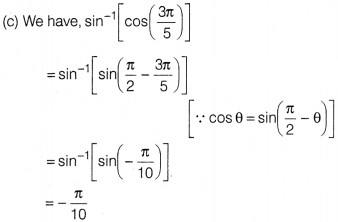
Assertion-Reason Based Questions
In the following questions, a statement
of Assertion (A) is followed by a statement of Reason (R). Choose the correct
answer out of the following choices.
(a) Both A and R are true and R is the
correct explanation of A
(b) Both A and R are true but R is not the correct
explanation of A
(c) A is true but R is false
(d) A is false but R is
true
Question 19.
Assertion (A) f(x) is continuous at x = a, if![]()
Reason (R) If fix) is continuous at a point, then
\(\frac{1}{f(x)}\) is also continuous at the point.
Solution:
(c)
Assertion We know that![]()
x = a, while both limits must exist.
Reason If f(x) is
continuous at a point, then it is not necessary that \(\frac{1}{f(x)}\) is also
continuous at that point.
e.g. f(x) = x is continuous at x = 0 but
\(\frac{1}{f(x)}=\frac{1}{x}\) is not continuous at x = 0
Question 20.
Assertion (A) The matrix
matrix of order 3.
Reason (R) If A =
[aij]m×l, then A is column matrix.
Reason In general, A
= [a,y]m x -i is a column matrix.
Solution:
matrix of order 3.
Reason in general, A =
[aij]m×1, is a column matrix.
Section
B
(This section comprises of very
short answer type questions (VSA) of 2 marks each)
Question 21.
Evaluate \(\int_0^1\frac{2x}{5x^2+1}\)dx.
Or
Evaluate
\(\int_0^2\)[x²]dx, where [•] is the greatest integer function.
Solution: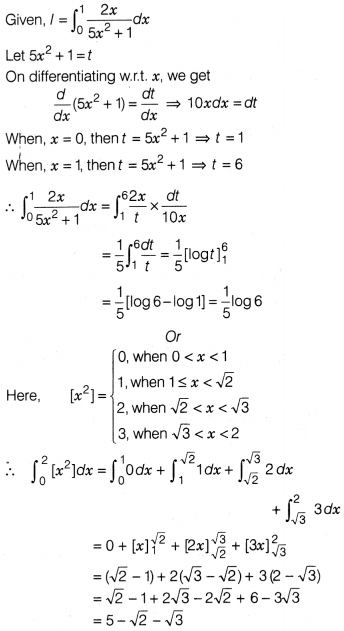
Question 22.
Evaluate ∫(x + 1) ex log (xex)dx.
Solution:
Let l = ∫(x + 1) ex log (xex)dx
On
putting, xex = t ⇒ (ex + xex)dx = df
⇒ (1 +
x)exdx = dt![]()
[using integration by parts]
= t.logt – ∫1dt = t.logt – t
+ C
= xex log(xex) – xex +C [∵ t =
xex]
= xex[log(xex) – 1] + C
Question 23.
A committee of 4 students is selected at random from a group
consisting of 8 boys and 4 girls. If there is atleast one girl in the committee,
then calculate the probability that there are exactly 2 girls in the
committee.
Or
If P(A) = \(\frac{1}{4}\), P(B) = \(\frac{1}{5}\) and P(A ∩
B) =\(\frac{1}{7}\), then find
P(\(\overline{\mathrm{A}}/\overline{\mathrm{B}}\)).
Solution:
Let A
denotes the event that atleast one girl will be chosen and B denotes the event
that exactly 2 girls will be chosen. Then, to find
P(\(\overline{\mathrm{B}}/\overline{\mathrm{A}}\))
Now, P(A) = 1 –
P(\(\overline{\mathrm{A}}\)) = 1 – P (no girl is chosen)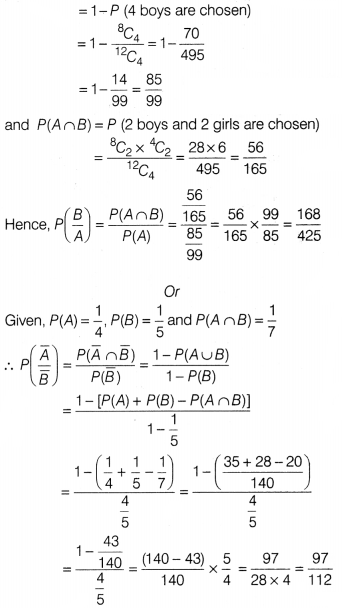
Question 24.
A balloon which always remains spherical has a variable
diameter \(\frac{3}{2}\)(2x + 1). Then, find the rate of change of its volume
with respect to x.
Solution:
Given, diameter of the balloon =
\(\frac{3}{2}\)(2x + 1)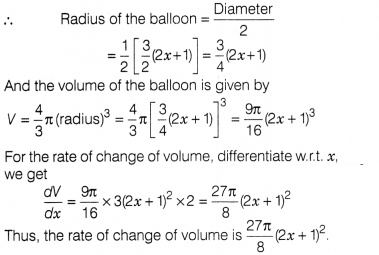
Question 25.
Given, \(\vec{a}+\vec{b}+\vec{c}\) = 0 |\(\vec{a}\)| = 5,
|\(\vec{b}\)| = 6 and |\(\vec{c}\)| = 9, then find angle between \(\vec{a}\) and
\(\vec{b}\).
Solution: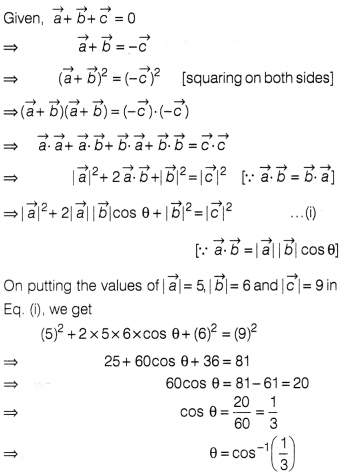
Section
C
This section comprises of short
answer type questions (SA) of 3 marks each
Question 26.
Three persons A, B and C apply for the job of Manager in a
private company. Chances of their selection (A, B and C) are in the ratio 1 : 2
: 4. The probabilities that A, B and C can introduce changes to improve profits
of the company are 0.8, 0.5 and 0.3, respectively. If the change does not take
place, find the probability that it is due to the appointment of C.
Solution:
Let us define the following events
A = Selecting person A
B =
Selecting person B
C = Selecting person C
Let E = Event of introducing the changes in their profit.
Also, given P(\(\frac{E}{A}\)) = 0.8, P(\(\frac{E}{B}\)) = 0.5 and
P(\(\frac{1}{C}\)) = 0.3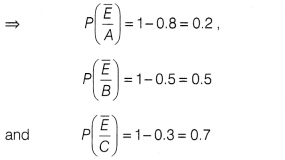
The probability that change does not take place due to the
appointment of C,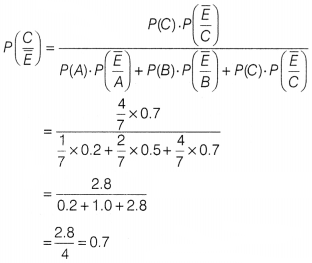
Question 27.
Evaluate ∫\(\frac{dx}{1-3sin x}\)
Or
Solution: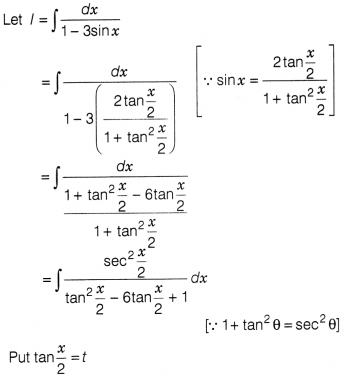
On differentiating both sides w.r.t. x, we get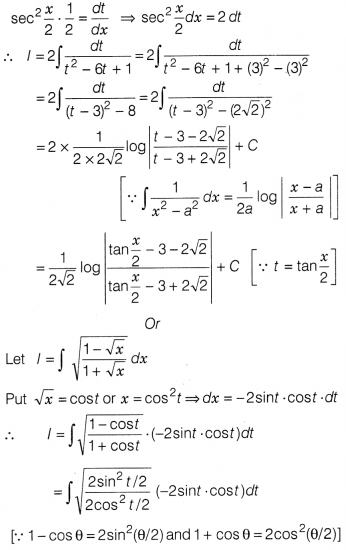
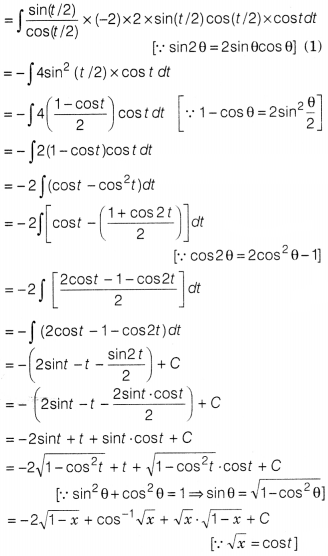
Question 28.
Solve the following differential equation
x(\(\frac{dy}{dx}\)) = y – x tan(\(\frac{y}{x}\))
Or
Solve the following
differential equation
x cos(\(\frac{y}{x}\))\(\frac{dy}{dx}\) = y
cos(\(\frac{y}{x}\)) + x; x ≠ 0
Solution:
Given, differential equation
is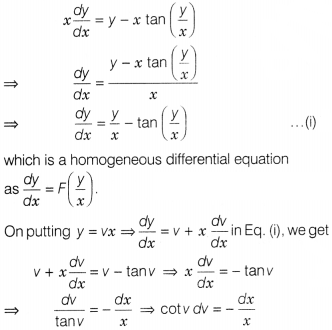
On integrating both side, we get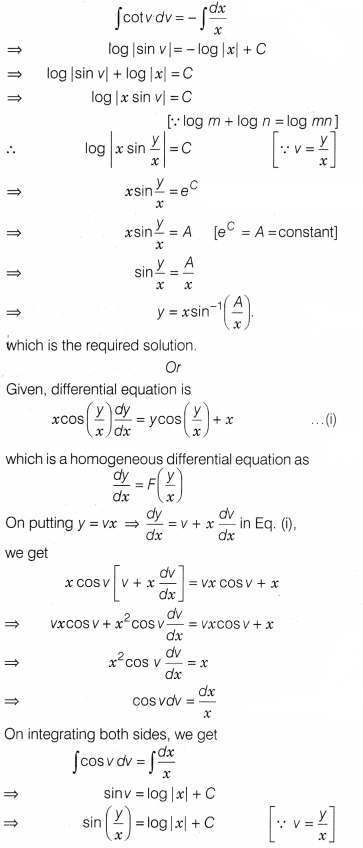
witch is the required solution of given differential
equation.
Question 29.
For any two vectors \(\vec{a}\) and \(\vec{b}\), show
that
(l + |\(\vec{a}\)|²)(1 + |\(\vec{b}\)|²) = {(1 – \(\vec{a}.\vec{b}\))}²
+ |\(\vec{a}+\vec{b}\) + (\(\vec{a}\times\vec{b}\))|²
Or
Solution: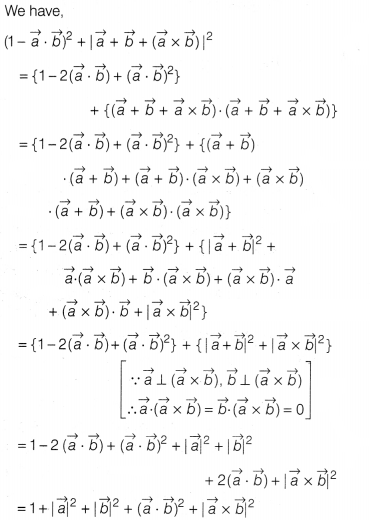
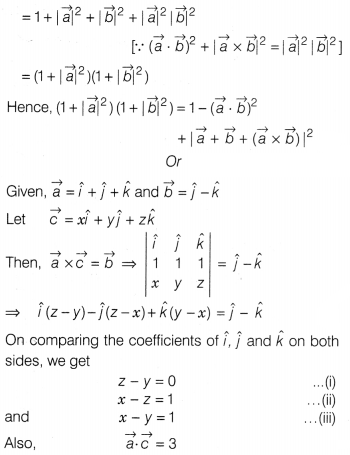
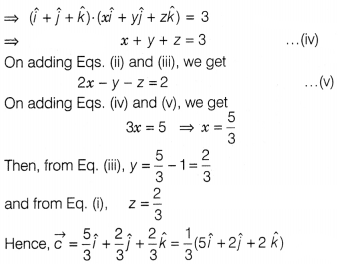
Question 30.
Bag A contains 4 black and 6 red balls and bag B contains 7
black and 3 red balls. A die is thrown if 1 or 2 appears on it, then bag A is
chosen, otherwise bag B. If two balls are drawn at random (without replacement)
from the selected bag, then find the probability of one of them being red and
another black.
Solution:
Given, bag A = 4 black and 6 red balls
and bag
B = 7 black and 3 red bails.
Let E1 = The event that die shows 1
or 2
E2 = The event that die show 3 or 4 or 5 or 6
E = The
event that among two drawn balls, one of them is red and other is black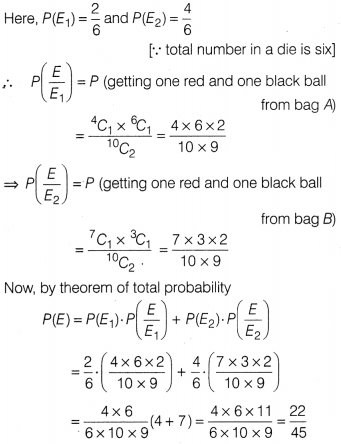
Question 31.
Find the shortest distance between the
Solution:
Given equations of lines are
On comparing above equations with one point form
of
equation of line, which is
\(\frac{x-x_1}{a}=\frac{y-y_1}{b}=\frac{z-z_1}{c}\),
we get
a1
= 1, b1 = -2, c1 = 1, x1 = 5, y1 =
7, z1 = 9 and a2 = 7, b2 = 8, c2 =
1, x2 = -1, y2 = – 1, z2 = -1
We know that
the shortest distance between two lines is given by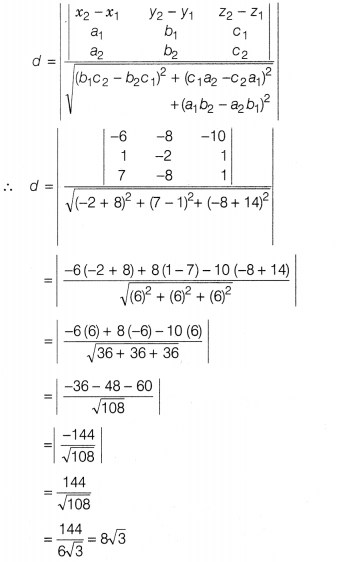
Hence, the required shortest distance is 8√3 units.
Section
D
This section comprises of long
answer type questions (LA) of 5 marks each
Question 32.
Show that the function f : R → R defined by f(x) =
\(\frac{x}{x^{2}+1}\) ∀ x ∈ R is neither one-one nor onto.
Solution:
Given, f : R → R, defined by
f(x) = \(\frac{x}{x^{2}+1}\) ∀ x ∈ R
Let
x1 x2 ∈ R such that f(x1) =
f(x2)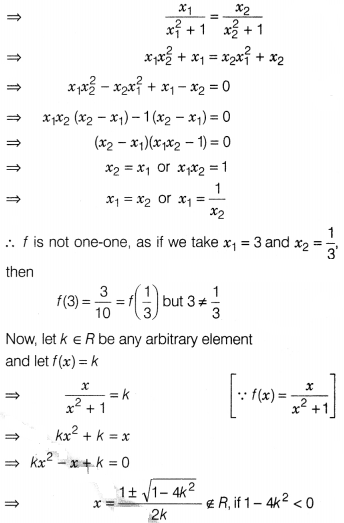
or (1 – 2k) (1 + 2k) < 0 i.e. k > 1/2 or k <
-1/2
So, f is not onto.
Hence, f is neither one-one nor onto.
Question 33.
Solve the following system of equations by matrix method when
x ≠ 0, y ≠ 0 and z ≠ 0.
Or
The sum of three numbers is 6. Twice the third number
when added to the first number gives 7. On adding the sum of the second and
third numbers to thrice the first number, we get 12. Find the numbers, using
matrix method.
Solution:
Given, system of equations is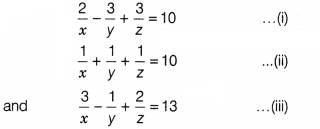
Given equations can be written in matrix form as AX =
B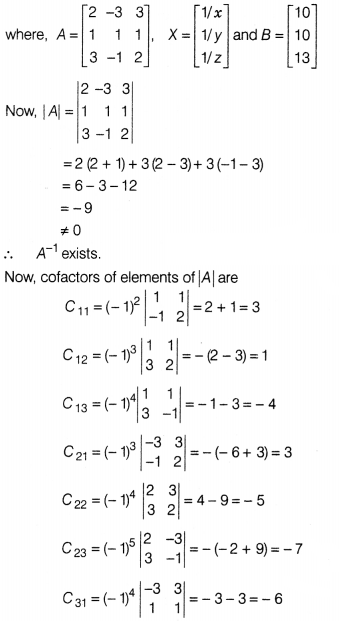
On comparing the corresponding elements, we get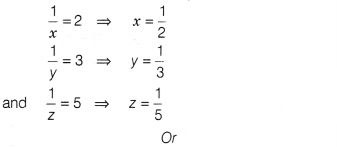
Let the first, second and third numbers be x, y and z,
respectively. Then,
x + y + z = 6 …(i)
x + 2z = 7 …(ii)
3x + y+z = 12
…(iii)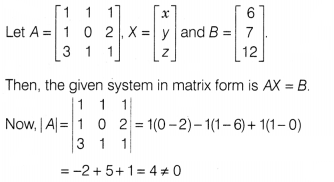
∴ A is invertible.
So, the given system has a unique
solution, X = A-1B.
The minors of the elements of |A| are
M11 = -2, M12 = -5, M13 = 1,
M21
= 0, M22 = -2, M23 = -2,
M31 = 2,
M32 = 1, M33 = -1
The cofactors of the elements of j
/4| are
A11 = -2, A12 = 5, A13 = 1,
A21 = 0, A22 = -2, A23 = 2,
A31 =
2, A32 = -1, A33 = -1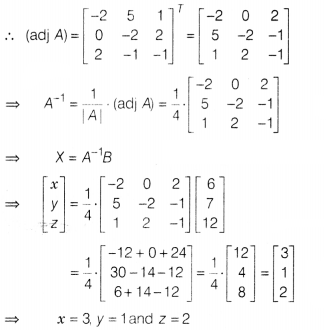
Hence, the required numbers are 3, 1 and 2.
Question 34.
Find the value of p, so that the lines
are perpendicular to each other. Also, find the equation of a
line passing through a point (3, 2, -4) and parallel to line l1.
Or
Find the shortest distance between the lines
Also, find the equations of the shortest distance.
Solution:
Given equation of lines can be written in standard form as
Direction ratios of these lines are -3, \(\frac{p}{7}\), 2
and –\(\frac{3p}{7}\), 1, -5, respectively.
We know that two lines with
direction ratios a1, b1, c1 and a2,
b2, c2 are perpendicular to each other, if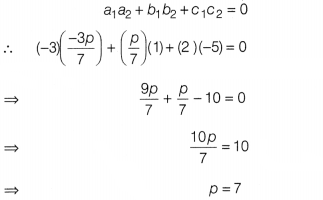
Thus, the value of p is 7.
Also, we know that the equation
of a line which passes through the point (x1, y1,
z1) with direction ratios a, b and c is given by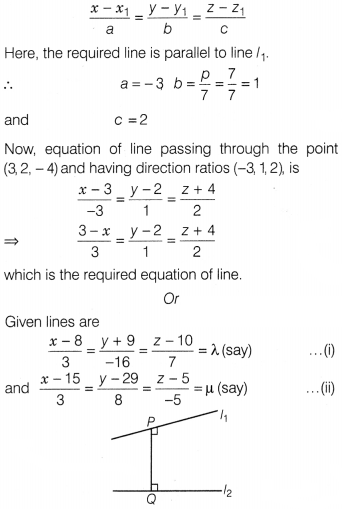
Any point P on line (i) is
P(3λ + 8, -16λ – 9, 7λ + 10)
…(iii)
and any point G on line (ii) is
Q(3µ + 15, 8µ + 29, -5µ + 5) …
(iv)
So, the direction ratios of PQ are
(3µ + 15 – 3λ – 8, 8µ + 29 + 16λ +
9, – 5µ + 5 – 7λ – 10)
i.e. (3µ – 3λ + 7, 8µ + 16λ + 38, -5µ – 7λ – 5)
Now, |PQ| will be the shortest distance between lines (i) and (ii), if PQ is
perpendicular to both lines (i) and (ii)
3(3µ – 3λ + 7) – 16(8µ + 16λ + 38) +
7(-5µ – 7λ – 5) = 0 [∵ a1a2 + b1b2 +
c1c2 = 0]
⇒ 9µ – 9λ + 21 -128µ – 256λ – 608 – 35µ – 49λ
– 35 = 0
⇒ -154µ – 314λ – 622 = 0
⇒ 77µ + 157λ + 311 = 0 [dividing by
(-2)] …(v)
and 3(3µ – 3λ +7) + 8(8µ + 16λ + 38) -5(-5µ – 7λ – 5) = 0 [∵
a1a2 + b1b2 +
c1c2 = 0]
⇒ 9µ – 9λ + 21 + 64µ + 128λ + 304 + 25µ + 35λ
+ 25 = 0
⇒ 98µ + 154λ + 350 = 0
⇒ 7µ + 11λ + 25 = 0 [dividing by 14]
…(vi)
On multiplying Eq. (vi) by 11 and then subtracting it from Eq. (v), we
get
(77µ + 157λ + 311) – (77µ + 121λ + 275) = 0
⇒ 36λ + 36 = 0 ⇒ λ =
-1
On putting the value of λ in Eq. (v), we get
77µ + 157(-1) + 311 = 0
⇒
77µ – 157 + 311 = 0
⇒ 77µ + 154 = 0
⇒ µ = -2
On putting the values of 3 and (i in Eqs. (iii) and (iv), we get
Coordinates of P = (-3 + 8, 16 – 9, -7 + 10) = (5,7, 3)
and coordinates of Q
= (-6 + 15, -16 + 29, 10 + 5)
= (9, 13, 15)
∴ Shortest distance between
two lines,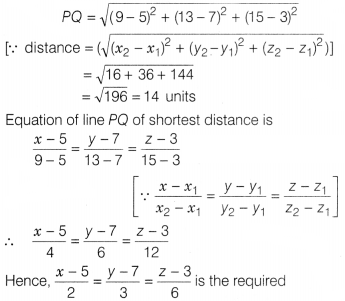
equation of the line which gives shortest distance.
Question 35.
Find the minimum value of (ax + by), where xy =
c².
Solution:
Let f(x) = ax + by, whose minimum value is required.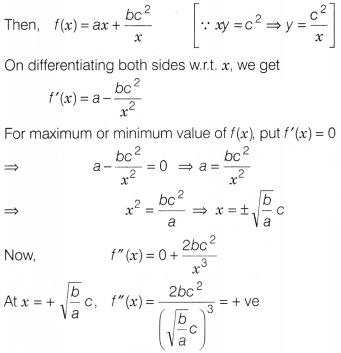
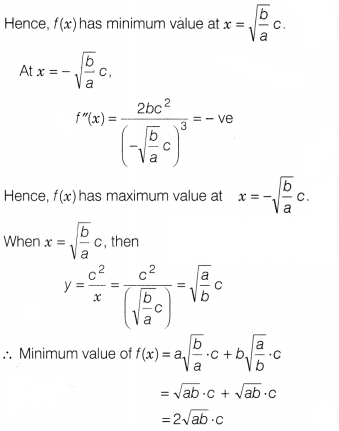
Section
E
This section comprises of 3
case-study/passage-based questions of 4 marks each
Question 36.
If A = [aij] be a m × n matrix, then the matrix
obtained by interchanging the rows and columns of A is called the transpose of
A.
A square matrix A = [aij] is said to be symmetric, if
AT = A for all possible values of i and l.
A squere matrix A =
[aij] is said to be skew-symmetric, if AT = -A for all
possible values of i and j.
Based on the above information, answer the
following questions.
(i) Find the transpose of [1 – 2 – 5].
(ii) Find the
transpose of matrix (ABC).
(iii) Evaluate (A + B)T – A,
where
Or
Solution: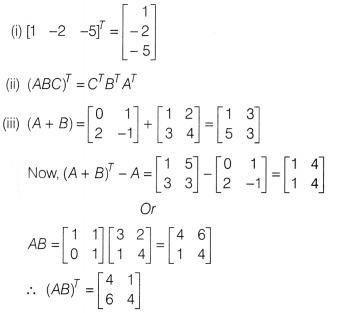
Question 37.
The feasible solution for a LPP is shown below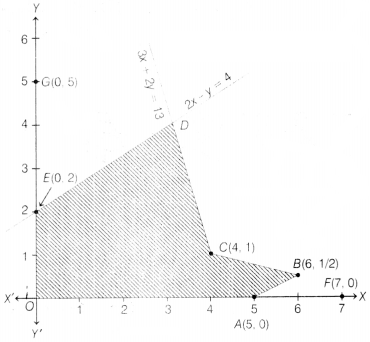
and the objective function is Z = 15x – 4y.
Based on the
above information, answer the following questions.
(i) Find the value of (n –
1)², where n is number of corner points.
(ii) Find Z (6,
\(\frac{1}{2}\)) + Z(0, 2)
(iii) Find the coordinate of
point D.
Or
Find the maximum of Z.
Solution:
(i) Since, shaded
region is OABCDEO.
The number of corner points, n = 6
∴ (n – 1)² =(6 – 1)²
= 5² = 25
(ii) Z (6, \(\frac{1}{2}\)) + Z(0, 2) = 88 + (-8) = 80
(iii) Given, equation of lines 3x + 2y = 13 …(i)
and 2x – y = 4 …(ii)
The point D is the intersection point of the above two lines.
On multiplying
by 2 in Eq. (ii), we get
4y – 2y = 8 …(iii)
On adding Eqs. (i) and (iii),
we get
7x = 21 ⇒ x = 3
From Eq. (ii), 2x – 4 = y
⇒ y = 2 × 3 – 4 =
2
Hence, the coordinates of point D are (3, 2).
Or
Value of objective
function at all corner points.
| Corner points | Value of Z = 15x – 4y |
| O(0, 0) | 15(0) – 4(0) = 0 |
| A(5, 0) | 15 × 5 – 4 × 0 = 75 |
| B(6, \(\frac{1}{2}\)) | 15 × 6 – 4 × \(\frac{1}{2}\)) = 88 (Maximum) |
| C(4, 1) | 15 × 4 – 4 × 1 = 56 |
| D(3, 2) | 15 × 3 – 4 × 2 = 37 |
| E(0, 2) | 15 × 0 – 4 × 2 = -8 (Minimum) |
∴ Maximum of Z is 88.
Question 38.
Consider the given equation \(\frac{dy}{dx}\) + Py = Q.
The above equation is known as linear differential equation. Here, IF =
e∫Pdx and solution is given by y . IF = ∫Q . IF dx + C
Now,
consider the given equation
(1 + sin x)\(\frac{dy}{dx}\) + ycos x + x =
0.
On the basis of above information, answer the following questions.
(i)
What is the solution of the given equation?
(ii) If y (0) = 1, then what is
the value of y(\(\frac{\pi}{2}\))?
Solution:
We have, (1 + sin
x)\(\frac{dy}{dx}\) + y cos x + x = 0